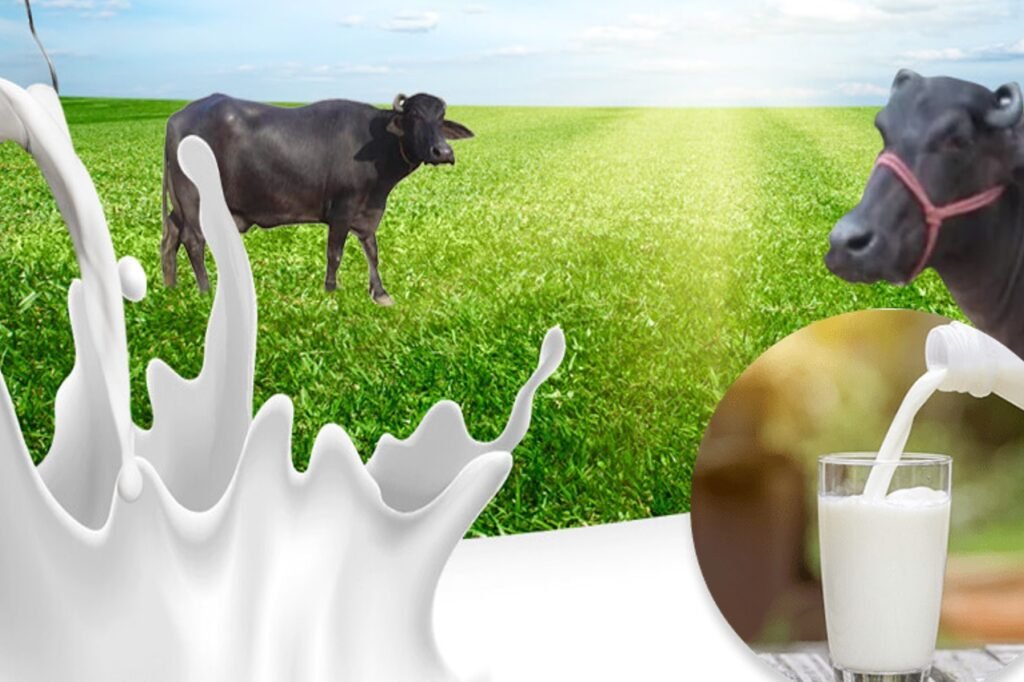WellHealthOrganic Buffalo Milk Tag
WellHealthOrganic Buffalo Milk Tag – A label or identification used to denote milk produced by buffalo. The high fat and protein content of buffalo milk makes it a popular substitute for dairy products like cheese and curd.
Buffalo milk is known for its creamy texture and rich taste. It is also believed to be more nutrient rich than cow’s milk, containing higher levels of calcium, iron and vitamin A.

What is buffalo milk?
Buffalo milk, also known as buffalo cow milk, is a dairy product extracted from female buffalo. This type of milk is highly nutritious and serves as an essential source of proteins, vitamins and minerals.
Wellheathorgaic buffalo milk has been consumed for centuries in various parts of the world, especially in India, Asia, and the Mediterranean region. It is renowned for its rich flavor and creamy texture, making it a popular choice in the production of a wide range of dairy products.
Composition and nutritional value
Buffalo milk has a higher fat content than cow milk, making it denser and richer. The composition of buffalo milk usually includes about 7–8% fat, 4.5–5% protein, 4.9% lactose and 0.7% minerals and vitamins. The high fat content contributes to its creamy texture and distinctive flavour, making it an ideal choice for the production of cheese, curd and butter.
Health Facilities
Wellhealthorganic buffalo milk offers various health benefits due to its rich nutritional profile. It is an important source of essential nutrients such as calcium, phosphorus and vitamin A, which are important for bone health and overall well-being. Additionally, the high protein content in buffalo milk aids in muscle growth and repair. Additionally, buffalo milk has lower cholesterol levels than cow milk, making it a healthy option for people who want to manage their cholesterol levels.
Difference between buffalo milk and cow milk
Buffalo milk and cow milk are two popular types of milk consumed around the world. Although they both come from mammals, there are several important differences between the two. These differences lie in fat content, protein content, digestibility and lactose. Understanding these differences can help you make an informed choice when it comes to selecting the type of milk that best suits your needs.
Fat content
The main difference between buffalo milk and cow milk is the fat content. Buffalo milk has higher fat content than cow milk. On average, buffalo milk contains about 7-8% fat, while cow milk usually contains about 3-4% fat.
This high fat content gives buffalo milk a rich and creamy texture, making it an excellent choice for producing high-quality dairy products such as cheese, butter and curd. Additionally, the increased fat content in buffalo milk contributes to its higher caloric value compared to cow milk.
Protein content
Another important difference between buffalo milk and cow milk is in their protein content. Buffalo milk contains more protein than cow milk. On an average, buffalo milk contains about 4.5-5% protein, while cow milk contains about 3-3.5% protein.
The high protein content in buffalo milk makes it an excellent choice for individuals who want to increase their protein intake. Additionally, the high protein content contributes to buffalo milk’s ability to form a thick consistency in products such as yogurt and cheese.
Digestibility and lactose
Buffalo milk also differs from cow milk when it comes to digestibility and lactose content. While both types of milk contain lactose, the sugar found in milk, buffalo milk has less lactose than cow’s milk.
The low lactose content in buffalo milk makes it easier to digest for individuals who are lactose intolerant or have difficulty digesting cow’s milk. However, it is important to note that buffalo milk still contains lactose and may not be suitable for individuals with severe lactose intolerance.
Furthermore, the fat globules in buffalo milk are generally smaller and more uniform than those in cow milk. This small size is believed to contribute to the ease of digestion and absorption of buffalo milk.
Understanding the difference between buffalo milk and cow milk can help you decide which type of milk is best for you. Buffalo milk is high in fat and protein, making it a great alternative to dairy products. It is also low in lactose, which may make it easier for some individuals to digest. Consider your specific dietary needs and preferences when choosing between buffalo and cow milk.
Use of buffalo milk
Buffalo milk, often referred to as “liquid gold,” is extremely versatile and packed with nutritional benefits. It can be used to make a range of delicious dairy products such as butter, cheese, yogurt and ice cream, delivering a creamy and rich flavor that is sure to please any palate.
Enjoy the goodness and versatility of buffalo milk in your everyday recipes!
Traditional dairy products
Buffalo milk, known for its rich and creamy texture, has been used for centuries to make a variety of traditional dairy products. These products not only provide delicious taste but also provide nutritional benefits. Here are some popular traditional dairy products made from buffalo milk:
- Curd: Buffalo milk is used to make thick and creamy curd, which is widely loved due to its tangy taste and probiotic properties.
- Butter: The high fat content in buffalo milk makes it ideal for butter production. Rich in Vitamin A, D, E and K, buffalo milk butter adds creamy and delicious taste to various dishes.
- Ghee: A staple in Indian cuisine, ghee made from buffalo milk is a clarified butter known for its aromatic flavor and high smoke point. It is often used in cooking, frying, and even in traditional Ayurvedic medicine.
- Khoya: Khoya, a popular ingredient in Indian sweets, is made by boiling buffalo milk until it becomes solid. This dairy product forms the base of dishes like gulab jamun and barfi.
Cheese production
Buffalo milk is also widely used in cheese production, producing rich and tasty varieties. The high fat and protein content of buffalo milk contributes to the unique flavor and texture of these cheeses. Some famous buffalo milk cheeses include:
- Mozzarella di Bufala: Originating from Italy, this soft and creamy cheese is a favorite topping for pizza and salads.
- Blue Cheese: Buffalo milk makes a distinctive and mild blue cheese, known for its creamy texture and distinctive blue veins.
- Ricotta: Buffalo milk ricotta cheese is smooth, creamy, and versatile. It is often used in both sweet and savory dishes, such as lasagna, cannoli, and cheesecakes.
- Paneer: A popular cheese in Indian cuisine, buffalo milk cheese is hard and slightly crunchy, making it a great addition to curries, stir-fries and grilled dishes.
The versatility of buffalo milk in producing a variety of dairy products makes it an essential ingredient in cuisines around the world. From traditional favorites to delicious recipes, the uses of buffalo milk are truly endless.
Buffalo milk around the world
Buffalo milk is a prized commodity that is enjoyed in various forms across the world. It has cultural significance and is used to make popular products that have become a staple in many cuisines. Let’s take a closer look at how buffalo milk is used and celebrated globally.
Popular Buffalo Milk Products
Buffalo milk is converted into many delicious products which are loved in many countries. Some of the most popular buffalo milk products include:
- Mozzarella di Bufala: A creamy and delicious cheese originating from Italy.
- Buffalo milk curd: Known for its rich and creamy texture, buffalo milk curd is a favorite in India and the Middle East.
- Ghee: A beloved clarified butter used in Indian cooking, known for its nutty flavor and high smoke point.
Cultural significance
Buffalo milk holds immense cultural importance in many regions, playing an important role in traditional cuisine and rituals. In India, buffalo milk is a symbol of prosperity and is often offered at religious ceremonies. In Italy, it is a key ingredient in the production of authentic mozzarella, contributing to the country’s rich culinary heritage.
WellHealthOrganic Challenges and Opportunities in the Buffalo Milk Industry
As demand for alternative dairy products increases, the buffalo milk industry presents both challenges and opportunities for dairy farmers and entrepreneurs. Understanding key areas of focus, such as breeding and genetics, and implementing effective marketing strategies can help achieve success in this emerging industry.
Reproduction and genetics
Optimization of breeding and genetics is important in the buffalo milk industry as it directly affects milk production, quality and overall profitability. Farmers need to pay attention to:
To select high yielding buffalo breeds with best milk production capabilities.
To ensure proper genetic management to avoid inbreeding and maintain genetic diversity.
To implement advanced breeding technologies to increase breeding efficiency and increase the number of productive animals in the herd.
We are regularly monitoring and evaluating the genetic potential of individual animals to make informed breeding decisions for long-term improvement.
Marketing strategies
- Successful marketing of buffalo milk products requires a well-defined strategy to reach target consumers and differentiate them from other dairy competitors. Some effective marketing strategies include:
- Recognizing and understanding the unique selling points of buffalo milk such as its rich flavor, high fat content and potential health benefits.
- Creating attractive and informative packaging highlighting the uniqueness of buffalo milk products.
- To collaborate with local retailers and supermarkets to ensure wide availability and visibility of buffalo milk products.
- Establishing direct channels of distribution such as online platforms to reach consumers interested in specific and niche dairy products.
- To connect with consumers through social media platforms, blogs and educational content to increase awareness about buffalo milk and its various uses.
FAQ (Wellhealthorganic buffalo milk tag)
How can you tell the difference between cow milk and buffalo milk?
You can tell the difference between cow milk and buffalo milk by their taste, texture and fat content. Cow milk is creamier and sweeter, while buffalo milk has a higher fat content and the flavor is more intense and rich. Visually, buffalo milk is whiter in color than cow’s milk.
Is buffalo milk A1 or A2?
Buffalo milk can be both A1 and A2, as it contains both types of beta-casein proteins.
What is special in buffalo milk?
Buffalo milk is special because it has more fat, protein and minerals than cow milk, making it creamier and richer in taste. It is also easy to digest and is high in calcium and iron, making it a healthy option.
Is it okay to mix cow and buffalo milk?
Mixing cow and buffalo milk is safe, but the taste and texture may change. Both provide similar nutrients.
Conclusion
Wellhealthorganic buffalo milk tag is a versatile and nutrient-rich alternative to cow’s milk. The unique properties of buffalo milk make it valuable for a balanced diet and offer potential health benefits. Including buffalo milk products in your lifestyle can enhance your culinary experience.




